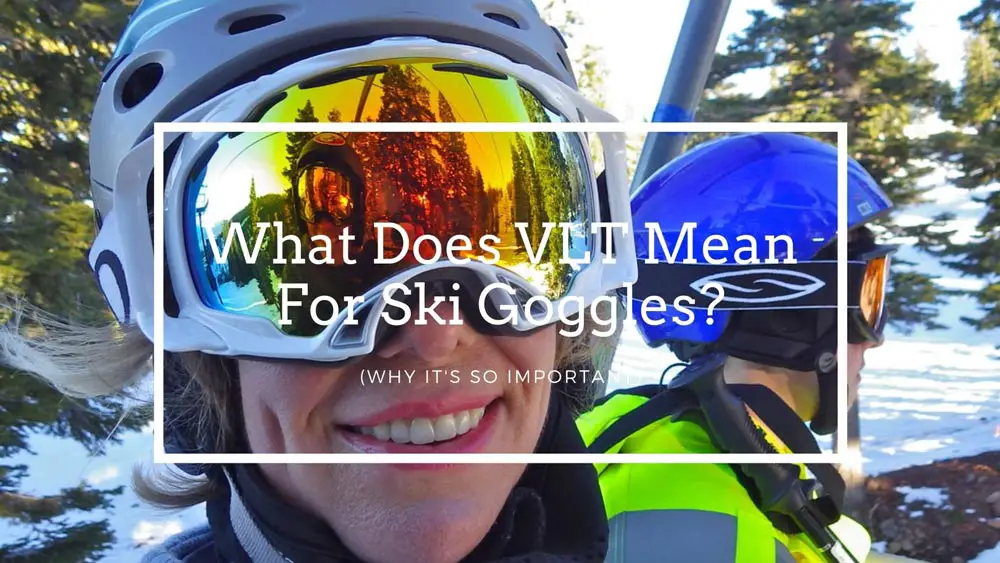If you’ve been considering exploring the world of skiing, you might have come across the term VLT in ski goggles. Here’s what it means.
Sure, skiing can be fun and exciting; however, you can find yourself at a loss without the right gear. From snowboards to ski goggles, there are several things you need to purchase in preparation for skiing.
If you have been thinking “What does VLT mean for ski goggles” but couldn’t figure it out, don’t worry. We’ve covered the topic in this informative guide.
Take a look!
What Does VLT Mean For Ski Goggles?
VLT, or Visible Light Transmission, is a ranking percentage that tells the buyer how much light can penetrate through the ski goggles. Ski goggles are one of the essential gears you need to purchase if you plan on skiing. This vital gear protects your eyes from snow, debris, and other elements which may cause injury.
Furthermore, it is crucial to find the right fit and VLT for your ski goggles. Without this, you run the risk of injuring your eyes on fallen tree limbs, branches, dried leaves, and flying snow.
Also, it is essential to find ski goggles that fit securely on your head. A lot of amateur skiers opt for sunglasses instead of goggles; however, this is a fallacy, as sunglasses can easily fall off while skiing.
VLT Options For Your Ski Goggles
There are a couple of options you can explore when looking for the best goggles for skiing. As such, these are a few standard VTL options you can consider:
- Photochromic Goggle Lenses
- Polarized Goggle Lenses
- Mirrored Goggle Lenses
Typically, ski goggles come in a range of VLT ratings such as –
- 9 – 13%
- 15 – 19%
- 50 – 60%
So, not only can you choose the color and type of lenses you want for the ski goggles, but also its range.
What Is A Good VLT For Ski Goggles?
For flat light, the best VLT for ski goggles would have a range of 60 to 90%. However, this also depends largely on the brightness, sunlight, and outdoor conditions. So, other types of lenses may be more appropriate for sunny days when you are looking to block out most of the harsh glare and sunlight.
An excellent feature of the newer versions of ski goggles is that they feature interchangeable magnetic lenses. This allows you to swap the lenses as per your requirements.
As such, the lower the VLT rating, the less light penetrates through the lenses of the goggles into your eyes. Silver, red, and dark gray lenses typically feature lower VLT ratings. On the other hand, red-orange, amber, and green-blue lenses generally have a higher VLT rating.
Another way to pick the right VLT rating for ski goggles is to consider the outdoor conditions. The darker it is outside, the higher the rating you should select. Keep in mind that the higher the rating, the more amount of light it will allow to penetrate through the lenses.
Similarly, the lower the rating, the lesser amount of light it allows, making it ideal for brighter conditions. The generic VLT rating for ski goggles is 20% – which is suitable for all conditions.
However, it is best to pick one that suits your requirements.
What Color Lens Is Best For Skiing?
If you are skiing on a bright, sunny day, you might want to opt for ski goggles with a low VLT rating of around 5 to 20%. Ideally, this should block out a considerable amount of glare and sunlight, enabling you to ski without interruption or hassle. Using a lens with a high VLT on bright days may result in eye strain and fatigue, as you will experience more stress on your eyes due to harsh sunlight.
Low VLT Ski Goggles Lens Color Options
- Red
- Copper
- Bronze
- Silver
- Dark grey
Moreover, opting for a mirrored finish can be beneficial compared to regular tinted glasses, as they reflect up to 65% more sunlight. This helps lower the VLT even further, blocking out the harsher rays of light.
Mid VLT Goggles Lens Color Options
Typically, mid VLT goggles have a range of 25 to 55%. These are the color options you can opt for:
- Rose or pink
- Blue-green
- Amber
- Red-orange
- Dark rose
Moreover, opting for mirrored or polarized lenses can help you achieve different levels of VLT within the same range of lenses.
Finally, dark, cloudy, or overcast days call for ski goggles with a VLT range of 65 to 90%. These high VLT goggles are ideal for skiing during the night or cloudy and overcast days.
High VLT Goggles Lens Color Options
- Yellow
- Light pink
- Rose
While these high VLT goggles provide minimal protection against sunlight and glare, they are excellent for protecting your eyes from other elements during skiing. Moreover, these VLT ski goggles help increase the contrast for snow, low light, and flat light conditions, increasing visibility and helping you enjoy a safe skiing trip.
All that said, if you are skiing in an environment where the lighting is very poor, it may be best to opt for clear or light yellow-tinted lenses, as they will give you better visibility and decrease the chances of accidents. When opting for the right color lenses for ski goggles, keep in mind that safety should be the priority and not the aesthetics of the goggles.
Conclusion
Well, that’s all we have for you today on this topic.
We hope this was an enjoyable read and helped you learn more about VLT for ski goggles and how it can help. If you are still confused about the appropriate VLT range to opt for, ensure that you speak to an expert who can help.
Your safety should always be the priority – so even though the rose-tinted ski goggles may look beautiful, ensure that you opt for the most suitable one for each environment.
Stay safe and happy skiing!


